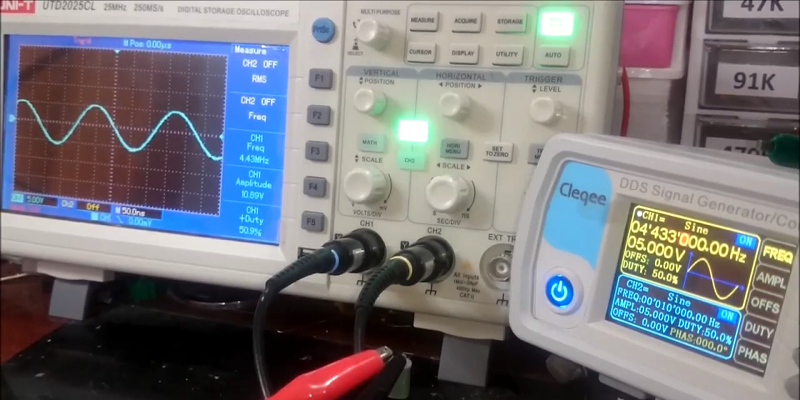It used to be any good electronics experimenter had a bag full of crystals because you never knew what frequency you might need. These days, you are likely to have far fewer because you usually just need one reference frequency and derive all the other frequencies from it. But how can you test a crystal? As [Mousa] points out in a recent video, you can’t test it with a multimeter.
His approach is simple: Monitor a function generator with an oscilloscope, but put the crystal under test in series. Then you move the frequency along until you see the voltage on the oscilloscope peak. That frequency should match the crystal’s operating frequency.
It is interesting that because of the resonance of the crystal, the voltage on the scope can be much higher than the input voltage from the signal generator. This is a simple test, but effective. Of course, you could also have a little oscillator and see what the crystal does in a real circuit.
We’ve tested crystals before with a network analyzer and we even made a video that shows essentially the same test [Mousa] uses, although it was on an LC circuit, not a crystal. You do need to be careful you aren’t operating the crystal in an overtone mode by accident, although presumably if it works on a harmonic, it should work on the fundamental frequency, too. We’ve also seen crystal testing and classification done with a software defined radio.
















You can also make a loop of wire with a few turns (an inch or so across), hook it up to a spectrum analyser and lay it over the crystal. It will pick up enough to show you the frequency.
Is there an app on an android that can tell you the frequency of a crystal or object? Or what would be the cheapest way to do this? New to this and trying to learn. Thanks
4433.619MHz!!! Wow 4GHz xtal!
Look again. Both the scope and the function generator are in agreement that the frequency is 4.43 MHz, a perfectly reasonable crystal frequency.
No, you look again.
4433.619 MHz is yelling in yellow
on top of the bloody red arrow.
(^ poetry)
:o)
Oh, sorry. I was looking at the actual photo of the actual test equipment, not some silly little video editing error.
No need for you to be sorry. It was the author’s typo.
Both times.
:o)
Nice post title :)
±1. No junkies were harmed in this test.
It’s actually a reference to the band “Crystal Method”. Well, I hope it is at least.
Why not put the crystal on channel A and the generator on channel B and set the scope to show A-B, then find the frequency at which the trace is closest to zero? (Or invert one of the channels and use A+B).
You could probably learn a lot about crystal oscillators from Leif’s project of building a low noise 14 MHz crystal oscillator with phase noise of -180 dBc/Hz @10kHz – http://www.sm5bsz.com/osc/newref.htm
In second of his technical videos for nerds only as he puts it, he measures 62 crystals, their serial resistance, main resonance frequency and spurs (spurious resonances) using a VNA. https://www.youtube.com/watch?v=e10BC32lutA
N2O PS1 game love it even now
Lovely play on words.
Seriously get the game, the music make it extreme! ????
“It used to be any good electronics experimenter had a bag full of crystals because you never knew what frequency you might need.”
Or who you needed to heal. ;-)
I used the same trick to measure the resonant frequency of a coil for a ferrite rod antenna.
For anybody who might have the same signal-generator, I once wrote a python-library to control that device remotely over USB: https://github.com/on1arf/jds6600_python
If you add some code to query the Vpp value of your oscilloscope, you can use this to write some python code to automate this process.
Or skip all that (including buying expensive equipment) and instead by a 1Hz-50MHz xtal tester/counter kit w/5 digits. Even Amazon carries it (from its store front) https://www.amazon.com/Frequency-1Hz-50MHz-Crystal-Counter-Housing/dp/B01L4BX6UO, which is even cheaper than Banggood’s price. I got one a year ago and it did ok on all of my crystals except 4MHz (some of their documents indicated there is a dead spot around 4MHz, but not why). There are also a bunch of YouTube videos on this.
This video did not “mention” how to test series vs. parallel resonant crystals, which can result in a significant frequency difference and possibly different aging and life, especially if over driven in an oscillator.
That link is not a crystal test fixture. There are not enough digits in the display and the output voltage is much too high.
Bad information
Good way to destroy the crystal. Must put a dropping resistor in series and realize a fnx gen is NOT a network analyser and RF drive levels may be high enough to destroy the crystal. Always beware of this sort of half baked hobby info. It’s usually wrong.
Sinned EE.
Thanks a lot, it works for me.